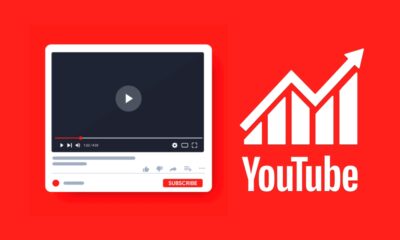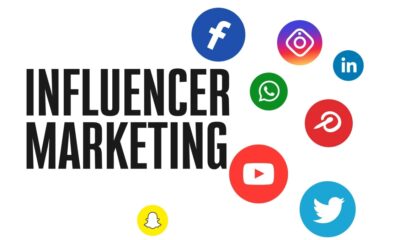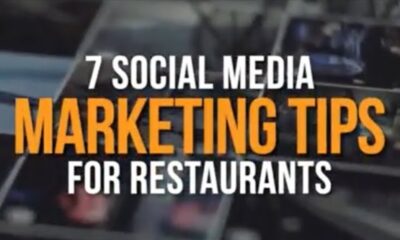Startup
How to Grow Your Business Through Social Media

Building your brand and interacting with customers are just two of the many ways you can use social media marketing to expand your company. Whatever your business goal, you should make sure you’re using the appropriate social media platform for it.
By selecting the best social media marketing tool and mastering its use, you can establish a reliable online presence that will support the expansion of your business at a reasonable cost. Discover how to use social media to your advantage to reach sales goals, attract new clients, and more.
How to Grow Your Business Through Social Media
Social media marketing, also known as digital marketing or e-marketing, links brands, and business owners with their target or existing customers using a variety of online social media platforms. Additionally, social media generates custom data analytics that offers superb, in-depth metrics that can assist you in determining whether particular approaches, services, or products are truly in demand by consumers.
Online, you can quickly and easily communicate with clients, research rival businesses, increase brand awareness, take online sales, and promote long-term business growth. To keep users on their platforms and away from rival websites, some social media companies even pay for engaging content. Thus, building a solid online presence may be beneficial in several ways.
Social media metrics provide useful information about audience engagement (likes, comments, shares, clicks), customer data (email addresses, phone numbers, etc.), referrals, and conversions. Businesses can use this input to enhance their social media marketing tactics and product offerings. You can also compare the online performance of your brand and make real-time adjustments.
Business Branding
Social media platforms are excellent means of showcasing your goods and services as well as your brand’s personality because of their broad audience reach. The visual components of your brand identity translate the mission, vision, and values of your company. This can include the distinctive designs, colors, and symbols that a company will employ on a regular basis. The company logo, which should be easily recognizable by customers and set it apart from competitors, is the most visible component of brand identity.
The written or spoken words that communicate the company’s values and principles are your slogan or mission statement. Although a lot of small business owners might believe that brand identity is limited to packaging, it encompasses much more. Identity facilitates a sense of connection between the company’s primary goal and the people who make up its core team, including its founders, employees, designers, and/or key spokespeople.
Social Media Platforms
As of October 2023, 4.95 billion people used social media around the world, accounting for approximately 61.4% of the world’s population, according to global data from Data Reportal.
The total is dispersed among several well-known platforms that cater to various consumer demographics and can be employed in various marketing campaigns.
While there are numerous worldwide options, these are some of the most well-known platforms in the United States:
Facebook: With almost 3 billion monthly active users from a cross-generational demographic, Facebook is the most widely used platform in the world.
Establishing business pages on Instagram that automatically share content across the platform—which also functions as an online store—can be advantageous for a variety of businesses. Facebook groups, which facilitate moderated or unmoderated discussions between like-minded people, also foster a feeling of community.
X (formerly known as Twitter): Businesses wishing to share succinct information, real-time updates, and customer engagement can all benefit from X. Under new ownership, this character-limited texting platform recently got a makeover. While some users have upgraded to X Premium, a paid subscription that provides more visibility, others have closed their accounts.
TikTok: Although it began as a platform for goofy voice-over videos, TikTok is quickly overtaking Instagram as the destination for visual content. Many content creators still find it simple to produce and monetize viral TikTok content that increases audience popularity and brand awareness, despite worries about data security. A lot of companies that make TikToks also share them on Instagram.
Instagram: Meta is the owner of the photo-sharing website Instagram. Instagram is meant for visual material, such as images or videos of food, travel, or lifestyle brands.
LinkedIn: Initially designed to link workers with recruiters and hiring firms, LinkedIn is a more professional and business-oriented platform. Businesses frequently have success using the platform to advertise jobs or produce newsletters that receive media attention.
Pinterest: Pinterest is a search engine that specializes in photos. The platform’s primarily female user base is active and uses it to make visual shopping lists for events, crafts, design projects, and the arts.
YouTube: TikTok and Instagram only allow 30-second video snippets; longer-form video content is available on YouTube. Here, entrepreneurs can provide password-protected or openly accessible content that is perfect for webinars, staff introductions, tours, tutorials, industry explainers, and other events, in addition to original content that can draw in viewers and clients.
Regular Posting
Creating content regularly is essential to optimizing your web presence. Create a content calendar so that you can plan messages for your audience on a regular basis. Every platform has a different algorithm, but the more content you create, the more exposure your content receives from the platforms to ever-bigger audiences. It usually entails posting every day for a minimum of thirty days in a row.
When in doubt, peruse the social media accounts of your rivals to gain insight from their triumphs and setbacks and to modify your material by market trends and viewer interest. The frequency of content creation and competitive listening may be too much for solopreneurs to handle. Using freelancers for projects can be beneficial. For different fees, community managers, copywriters, graphic designers, filmmakers, and editors can be employed to complete this task.
Customer Engagement
Posting content is just one aspect of engaging with your audience. Messages, shares, likes, comments, and other direct interactions with your audience are all possible. Using marketing techniques like giveaways, Q&A sessions, and live video streaming can help you build a relationship with your audience that will eventually result in sales. React quickly to messages and comments to demonstrate your responsiveness to online interest.
To answer frequently asked questions and mimic a customer service exchange, many business owners integrate chatbots into their Facebook accounts. This is but one strategy to keep users on the platform and off your phone and email support desk. Recall that social media is frequently about two-way communication, so your social media plan should include a plan for answering questions and comments.
Lead Generation
The best place to look for possible customers who might be interested in your product is on social media. By providing them with interesting or educational content, you can attract them and eventually win their business. Before spending any money on creating new goods or services, you can test ideas with consumers using social media.
To determine interest or accept pre-sales, consider posting pictures of a prototype. Make surveys to find out what your current clientele would like to see next and what price they are willing to pay for it. One of the greatest strategies for businesses of all sizes to expand their consumer base and create goods and services that people will be willing to buy is through social media.
Paid Advertising
Even though organic reach is important, many small businesses can gain from spending a little money on advertising to reach new customers. While the options for paid advertising vary depending on the platform, most involve running a campaign to show your video or other visual content to people in your target audience. This may increase traffic to the website or physical store of your company, resulting in higher sales. It can also do away with the requirement for a pricey marketing consultant or PR firm.
Your business could market its services to hundreds or even thousands of potential customers for just a few dollars a day. Often, the platform will display your content to the appropriate audience based on your specified location, gender, and age group. The cost of paid advertisements can range from $1 to $50 per day, depending on the audience you wish to reach, and the minimum duration of a campaign is usually 30 days.
How Can Social Media Help in the Growth of a Business?
Social media sites may be very helpful to a company’s expansion in several ways. They can aid in lead generation, better audience engagement, and brand visibility. Social media platforms can also offer a means of obtaining consumer insights and using targeted advertising. Lastly, it can support sales, conversions, and content distribution.
Which Social Media Platform Is Best for Businesses?
Every business will have distinct target markets, objectives, and preferred social media platforms. But among the most widely used social media sites for companies are YouTube, X, Facebook, Instagram, LinkedIn, Pinterest, TikTok, and Linked In.
How Often Should a Business Post on Social Media?
The exact objectives and target market of each company must be identified to decide how often to publish on social media. Additionally, the way that paid accounts or frequent posters are rewarded varies slightly amongst social media platforms’ algorithms. Post frequency is not as important as consistency and interaction with the intended audience. Based on research from Hootsuite, some good target ranges are:
- Pinterest: 3-30 pins per day.
- X (Twitter): 2-3 posts per day; pay attention to hashtags.
- Instagram: 3-5 posts per week, including stories, lives, reels, and posts.
- Meta (Facebook): 1-2 posts per day, including posts, lives, etc.
- TikTok: 3-5 posts per week.
- LinkedIn: 1-2 posts per day.
Is It Possible to Get Free Social Media Promotion for Your Business?
Social media marketing for businesses is cost-free. Businesses can post content and create free profiles on many social media platforms. Although organic reach may not reach as many potential customers as you’d like, it can help you connect with your current audience. To reach a larger audience, you may eventually want to think about investing in a small amount of targeted advertising.
Final Word
Effectively using the various social media platforms can greatly contribute to the expansion of your business. Remember your primary business objectives and financial constraints as you go over all of your social media marketing options. Among many other advantages, social media marketing allows you to reach a large audience and improve your brand, engage audiences, target advertising, and generate leads.
-

 Business4 weeks ago
Business4 weeks agoHow to fill MSME Form 1? Step-by-Step Guide
-
Business4 weeks ago
From Marine to Chief: The Leadership Journey of Sean Mannix
-

 Gadget4 weeks ago
Gadget4 weeks agoAfter Grand Success on BLDC Ceiling Fan, Eff4 Is Launching Smart Bulb
-

 Festivals & Events4 weeks ago
Festivals & Events4 weeks agoGoogle Celebrates Cherry Blossom Season with Animated Doodle
-

 Business2 weeks ago
Business2 weeks agoPrakash and Kamal Hinduja: Driving Social and Environmental Change
-
Education3 weeks ago
Fred DuVal: University Leadership as a Critical Resource for Climate Change Research and Life-Saving Solutions
-

 Sports4 weeks ago
Sports4 weeks ago2025 NASCAR Craftsman Truck Series Baptist Health 200 at Homestead-Miami Speedway: Race Preview, Prediction, Schedule, Entry List, Drivers to Watch and How to Watch
-

 Health2 weeks ago
Health2 weeks agoThe Hinduja Brothers Commitment to Global Health: Empowering Communities Across Borders

























